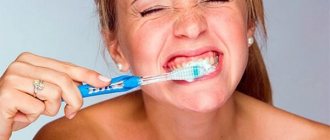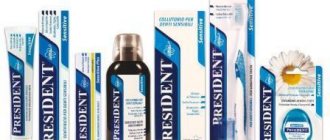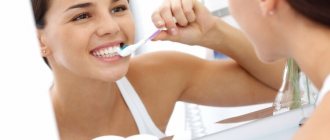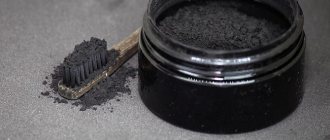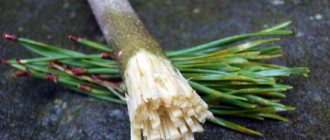Oral hygiene is important!
And the first thing that daily oral hygiene is associated with today is brushing your teeth.
and, of course, toothpaste. Although quite recently our grandmothers used dental cleaning powder. With the advent of toothpaste, the powder was forgotten. And now supporters of the powder method of brushing teeth are again appearing.
And here is the dilemma: what is healthier, tooth powder or toothpaste
?
The debate between supporters of one and the other method has been going on for a long time. Everyone defends their opinion.
From TV we hear every day about effective toothpastes, but almost no advertising for tooth powder. And this does not mean that the powder is ineffective.
Tooth powder or toothpaste - the choice is yours. But be sure to consult your dentist.
Purpose
It should be noted that at that time the purpose of tooth powder was not to prevent caries or treat periodontitis. At that time they did not even know such words, did not understand the reasons for their occurrence, and therefore could not yet contain these diseases with hygienic means. The main and only goal was to cleanse the teeth of plaque and tartar. Please note: in the first half of the 20th century, dentists had not yet performed such a now widespread procedure as professional oral hygiene. Neither ultrasonic nor air-abrasive (Air-Flow) treatment had yet been invented. The only way to remove conspicuous plaque is to clean it yourself.
Compound
chemically deposited chalk is used as the main component In addition, this product contains sodium bicarbonate , which acts as a preservative.
Otherwise, the composition of the product may differ depending on its intended purpose. Basically, the following components may be included in this product:
- white clay - acts as a soft abrasive, has a slight analgesic effect, reduces the symptoms of periodontal inflammation;
- sea salt – affects the acceleration of the process of soft tissue regeneration and actively fights bacteria;
- dry and ground medicinal plants . Soothe gums, reduce swelling, promote rapid healing;
- essential oils of mint, eucalyptus and other plants. They are powerful antiseptic and anti-inflammatory agents;
- nutmeg – increases the immune defense of the oral cavity and soothes inflamed tissue;
- ground cinnamon – has an antibacterial effect.
In combination with these components, the powders contain various flavors and fragrances.
Starting line-up
Therefore, a good century-old tooth powder is one that has excellent abrasive properties. Hence they added to it: pumice, sand, ground bones, eggshells, mollusk shells, broken bricks and God knows what else. It must be said that toothpastes of those times were in no way behind powders in terms of abrasiveness. Moreover, to help a good cause, individual inventors added acids and alkalis of varying degrees of aggressiveness to them. Well, of course - after all, tartar softened by acid is easier to remove (alkali has not proven its worth in this regard). In general, the evolution of hygiene products has moved towards clearly expressed aggressiveness.
Popular brands
Blend-a-med PRO-EXPERT effectively removes plaque, freshens breath, protects against caries and tartar, and reduces tooth sensitivity. Contains polyphosphates and stabilized tin, which have a beneficial effect on the condition of teeth and gums: strengthens and gently whitens the enamel.
To read: Exfoliative cheilitis
The German paste Lacalut is recommended for adults and children, which prevents the deposition of tartar, strengthens gums, and freshens breath.
International offers Colgate paste with a different set of medicinal herbs, anti-inflammatory, whitening, enamel strengthening effect,
“Forest balm”, as well as rinses based on medicinal herbs, with aloe vera, for various purposes, depending on the composition of medicinal plant components, are recommended for oral care and the prevention of dental problems.
Popular among consumers:
- Aquafresh,
- Paradontax,
- New pearls
- Splat Professional Active (does not contain fluorine).
Harm
But in 1907, an outstanding article was published in The Dental Cosmos: Miller WD. Experiments and observations of the wasting of tooth tissue variously designated as erosion, abrasion, chemical abrasion, denudation, etc. It had about the same impact on dentists as Albert Einstein’s “On the Electrodynamics of Moving Bodies,” published two years earlier, had on physicists. Equipped with terrifying illustrations, it clearly demonstrated the monstrous abrasion of teeth (in vitro) with pastes and powders. Here's one example:
Quality improvement
Of course, not all dentists read this study. Consumers of the powder certainly had no idea about it. Therefore, it took decades before highly abrasive components began to be abandoned. Such useful indicators as RDA (relative dentin abrasivity) and REA (relative enamel abrasivity) were introduced. The lower they are, the less the teeth wear out. Today, manufacturers who respect their customers indicate digital RDA values on each tube. Less than 70 – low abrasiveness, 71-100 – moderate, 101-150 – high, 151-200 – very high. Here is the RDA table for some modern pastes:
| Toothpaste name | RDA | Toothpaste name | RDA |
| Toothbrush with plain water | 4 | Colgate Sensitive Max Strength | 83 |
| Regular baking soda | 7 | Aquafresh Sensitive | 91 |
| Weleda Salt Toothpaste | 15 | Sensodyne Cool Gel | 92 |
| Elmex Sensitive Plus | 30 | Rembrandt Plus | 94 |
| Sensodyne ProNamel | 34 | Sensodyne Fresh Impact | 94 |
| Arm & Hammer Dental Care | 35 | Sensodyne Original | 100 |
| Weleda Calendula Toothpaste | 45 | Sensodyne Extra Whitening | 104 |
| Weleda Ratanhia Toothpaste | 45 | Sensodyne Full Protection Whitening | 107 |
| Arm & Hammer Dental Care Sensitive | 48 | Aquafresh Whitening | 113 |
| Tom's of Maine Children Toothpaste | 57 | Lacalut White | 120 |
| Colgate Sensitive Enamel Protect | 63 | Colgate Total Whitening | 142 |
| ClinPro | 65 | Colgate Total Advanced Fresh | 160 |
| Colgate Regular | 68 | Colgate Tartar Control | 165 |
| Colgate Total | 70 | Colgate 2-in-1 Tartar Control/Whitening | 200 |
| Colgate Fresh Mint | 70 | President White Plus | 200 |
Popular manufacturers
Nowadays you can buy tooth powders from different manufacturers, which differ in quality and cost. Separately, we can note the products of the following brands:
- Gum Gold. The main effect of this remedy is to relieve inflammation of periodontal tissue.
It contains more than 10 different medicinal plants that inhibit bacterial growth and activate regeneration processes. The average cost of this product is 300 rubles . - “Mint” from the Avanta .
The powder has a standard composition and is recommended for routine cleaning of crowns. Additional components gently soothe the gum tissue, reducing its sensitivity. This product is produced in Russia and has a low price - no more than 50 rubles. - “Whitening” from the Russian company Fitokosmetik .
The products do not contain fragrances, dyes or other chemical additives. Because of this, it is recommended for use by people suffering from allergies. The main effect of the product is crown whitening. The cost of this powder is on average 70 rubles .
Modern composition
So, coarse abrasives were disqualified from the contents of tooth powder. But what is there now? Soda, as can be seen from the table, has minimal harmful qualities. It is harmless, but its effectiveness is low. It weakly cleans plaque and does not “take away” tartar at all. Its hardness on the Mohs scale is 2.5. That's why the main ingredient in today's tooth powders is chalk (calcium carbonate). Its hardness on the Mohs scale is 3. It cleans teeth relatively gently and is more effective than soda. The rest is fragrances, flavor enhancers, dyes, etc.
Which is better: toothpaste or tooth powder?
It is difficult to say unequivocally which product is best to use for whitening - each has its own characteristics. It is best to make a choice based on your own priorities:
- if you need a product that is inexpensive and can whiten crowns quickly, tooth powder will be an ideal option;
- if you need a product that whitens teeth for a relatively long time, but gently and with a longer-lasting effect, it is better to choose a special paste. You should also choose a paste with chemical active ingredients if you want to lighten your teeth to a white shade: the abrasive can whiten teeth only to their natural color, which is not white at all, but beige - due to dentin showing through the enamel (in people with thin enamel, the natural color teeth may even be light yellow). Therefore, it is possible to give teeth whiteness in the literal sense of the word only through chemical action.
The final victory of toothpaste
Back in 1914, there were attempts to introduce fluoride into toothpaste. But only after large-scale research in the early 1950s, which proved the effectiveness of fluoride toothpastes, did active commercial production begin. The pioneer was Procter & Gamble with Crest toothpaste. Then the rest of the manufacturers picked up the baton. In addition to fluorides (to prevent caries), antiseptics and anti-inflammatory components (to fight gingivitis), and desensitizing substances (to reduce dental hyperesthesia) began to be added to the paste.
How to choose?
When choosing a toothpaste, pay attention to the addition to its name:
- Active – means that the product is recommended for periodontal disease,
- White – produces a whitening effect due to high abrasiveness and peroxide content (citric acid),
- Sensitive – designed to reduce excessive tooth sensitivity,
- Fito – contains medicinal herbs.
Then check: the integrity of the packaging (tube), the release date (expiration date - 3 years). Familiarize yourself with the composition of the components: fluoride concentration should not exceed 2%, abrasiveness should not exceed 100 according to the RDA standard.
Where in the world is it used?
In developed countries, tooth powder is not produced. The last known global leader in the hygiene industry, Arm & Hammer, ceased sales in 2000. In Russia, tooth powder is used by 23% of the population. A recent study was conducted in India in 2022: it was found that 31% of rural residents and 15% of urban respondents use tooth powder. A strong relationship has been found between the use of tooth powder and abrasion of tooth tissue, bleeding and gum recession. This is the “beauty” you get after consuming Indian tooth powder:
Recommendations for use
In order for the use of tooth powder to bring maximum benefits, you should follow some rules .
Storage
It is necessary, first of all, to ensure proper conditions for storing this product so that it retains its beneficial properties :
- Avoid exposure to direct sunlight;
- ensure an acceptable temperature in the room where the powder is stored: from 0 to 25°C;
- do not allow contact with water;
- ensure that the relative humidity does not exceed 70%.
General rules
The choice of a specific powder should be made using the advice of a dentist, who must take into account the individual characteristics of the patient - the condition of the soft tissues, the quality of the enamel, the presence of various problems or diseases in the oral cavity.
- Do not dip a wet brush directly into the product. You need to dilute a little product with water in a separate container and apply the resulting mixture onto a moistened brush.
- Use only a soft toothbrush to clean with powder . It can be distinguished by the “Soft” marking.
- Follow the recommendations for the duration of the procedure . The greatest cleaning effect is achieved in 3–5 minutes.
- In one procedure, you can do double brushing : first with full powder, and then with a soft and non-abrasive toothpaste.
- Use this product no more than once every three days.
- After the procedure, it is necessary to rinse the mouth very thoroughly to remove all remnants of the hygiene product, food particles and removed dental plaque.
How to brush your teeth correctly
Please note that despite the fact that most of the Indian tooth powder fan's own enamel has been erased, the black plaque has not been cleaned out everywhere. And this is on the front surface - you can imagine how much worse the situation is on the internal surfaces. This happens because brushing your teeth requires, first of all, not strength, but intelligence. Instead of violent movements, moderate but frequent movements are needed. Not horizontal, but vertical, sweeping. From the gum to the tooth: from bottom to top - on the lower jaw, from top to bottom - on the upper jaw. And, naturally, you need to brush your teeth not only on major holidays, but every day. Then the soft plaque will not yet have time to calcify and stick firmly to the enamel.
Composition of teeth cleaning powders
Each locality had its own recipe for tooth powder. Before people came to the idea that finely ground chalk could serve as its basis, the product was made from gypsum, corals and shells, animal horns or egg shells. And only later a chalk-based powder appeared, and various oils were used as a flavoring: anise, mint, cinnamon and clove flowers.
Later, with the development of the chemical industry, chalk began to be deposited chemically. As a result, it became even smaller. Then its composition was further enriched with magnesium carbonate, and the tooth powder stopped causing damage to the tooth coating. At the same time, it provided high-quality cleaning.
Modern tooth powder, the composition of which is much more complex than that of its ancestor, also has numerous additives that have preventive qualities. Chalk is not the main component. It can be replaced by white clay, and additional substances are, for example, volcanic tuff or sea minerals. Powders with this composition clean the teeth in a gentle manner and can act as an excellent prophylactic agent.
Features of use
For tooth powder, the instructions for use are a little more complicated than for toothpaste. The toothbrush should be moistened with water and the wet bristles should be dipped into a jar of powder. It is advisable to immediately collect a portion for the entire one-time cleaning. After all, when re-sampling, microorganisms will get into the powder. Bacteria, by the way, will still end up in the jar (unless you use disposable brushes), because they remain on the fibers from the previous cleaning. But in the 12 hours that have passed since the last hygiene procedure, most of the microbes have already died and do not pose any danger to the owner. The same cannot be said about other members of the family. Therefore, everyone should have a personal jar of tooth powder - otherwise there is a high risk of infecting close relatives. This is another inconvenience compared to toothpaste - the whole family can use a common tube.
Operating principle
The main active component of teeth cleaning powders is an abrasive. Unlike paste, the abrasive particles here have a coarser structure and pointed edges, like crystals.
When mechanically acting on the crown of a tooth using a product and a brush, small particles of the product seem to scrape off the pigmented layer and bacterial deposits, making the teeth noticeably cleaner and whiter.
It is difficult to achieve such an effect when using paste, since its effect is more reminiscent of polishing .
After removing the bacterial layer, the enamel pores open and the beneficial microelements included in the product penetrate through them. They spread into the deep tissues of the tooth, strengthening it.
Reviews
Why then are there such a huge number of positive reviews about tooth powder on the Internet and among friends? It’s not surprising - there are also a lot of words of praise about homeopathy and osteopathy. Valerian, Actovegin, Linex and a hundred or two other ineffective drugs find no less devoted admirers. A person is such an amazing creature that, having convinced himself of the usefulness of a particular drug, he can actually achieve a positive effect, even if this drug is an absolute dummy. This is called the placebo effect. After persistent self-hypnosis, the transition to truly more effective therapeutic and prophylactic agents is often met with hostility. Plus, irreversible negative consequences do not occur immediately. They include, among other things, the absence of a positive impact (prevention of diseases), which few fans think about.
LiveInternetLiveInternet
We all brush our teeth several times a day every day. For most people, this process is no longer possible without the use of some kind of toothpaste, the variety of which is currently very large.
How often have you thought about what substances are in the toothpaste that you use day after day, month after month? Probably the same as me - never. One day, a person very close to me recommended that I try using Microbright tooth powder instead of toothpaste. The effect amazed me, a pleasant feeling of freshness and cleanliness in the mouth, in a fairly short period of time (just a week) and I noticed that my teeth became much whiter, and the most important thing is the feeling during the teeth-brushing procedure, there is no more hated foam in my mouth! But I was wondering if using tooth powder is harmful to tooth enamel? I decided to look for something on this topic on the Internet. And what was my surprise, it turns out that brushing your teeth with tooth powder is not only useful, but also safe for life, which cannot be said about toothpastes. As it turned out, most toothpastes contain the following basic chemical elements: triclosan, fluoride, sodium lauryl sulfate. And all these components are far from safe for human health.
Triclosan – used as an antibacterial additive. In addition to harmful bacteria, it also destroys useful ones, which can cause dysbacteriosis. Triclosan is especially harmful to pregnant women. It can interfere with blood flow to the uterus, which causes oxygen starvation of the fetus.
Fluorine is a chemical element (“fluoros” is translated as “destructive”) and is classified as a toxic substance. When there is an excess of it in the body, phosphorus-calcium metabolism is disrupted. This has been proven by many studies. excess fluoride gets directly onto the tooth, . First, white spots appear on the teeth, then they turn yellow and then the tooth enamel is destroyed. It turns out that fluoride accumulates not only in teeth, but also in bones. It can change the structure of bone tissue, even causing bone cancer. Fluoride compounds have the most significant effect on the thyroid gland. Fluorine, like Iodine, is a halogen. Anyone who understands chemistry even a little knows that any halogen with a lower atomic weight replaces halogens with a higher atomic weight within its group in compounds. As is known from the periodic table, Iodine has a higher atomic weight than Fluorine. It replaces iodine in digestible compounds, thereby causing iodine deficiency. Chlorine, which is widely used for water purification, has the same properties, but it is less active than fluoride in chemical terms. A person has enough fluoride in his life, which he consumes along with apples, mineral water, tea and other products.
The most dangerous substance, which is part of 90% of toothpastes, is not fluoride, which has been talked about lately, but a foaming substance - sodium lauryl sulfate. Most often it is denoted by three Latin letters SLS or Cyrillic - PAV. It is this substance that, when it enters the oral cavity, foams and destroys plaque from tooth enamel. Lauryl and sodium lauryl sulfate penetrate and accumulate in various organs. They cause poisoning, eye diseases and cancer. Sodium lauryl sulfate dries out the oral mucosa, increases the sensitivity of the gums to allergens and irritants such as food acids, and is a strong abrasive, which leads to thinning of the enamel. The harm of toothpaste with SLS is also confirmed by ophthalmological studies: after using a toothpaste containing sodium lauryl sulfate, vision deteriorates by 5%. It turns out that the less foam, the better the quality of the toothpaste. The inscription SLS free means that the paste contains no foaming substance.
And that's not all the harmful chemicals contained in toothpastes!
Sorbitol , a liquid that keeps the paste from drying out, is a laxative and can cause diarrhea in children.
Paraffin - a substance derived from oil is responsible for making the paste look beautiful when squeezed out, but can cause pain in the abdomen and vomiting.
Formaldehyde negatively affects human genetics, respiratory organs, quality of vision and skin condition. Constant intake of small amounts of formaldehyde into the body can cause damage to the liver, kidneys and other pathological conditions.
The harm of toothpastes to humans is obvious!
Tooth powders were the only means of cleaning teeth before the advent of toothpaste. Initially, they were made on the basis of chalk, fine salt, and ground eggshells into powder. Tooth powder almost never contains chemical additives (foaming agents, dyes, surfactants), which are often added in large quantities to toothpastes.
Microbright Whitening Tooth Powder , with the refreshing mint flavor I mentioned at the beginning of my article, is the world's first antioxidant tooth powder containing Microhydrin from RBC (a Coral Club product).
Microbright tooth powder whitens teeth without the use of harsh abrasives and refreshes as well as cleans.
Microhydrin creates an alkaline environment in the oral cavity, which, by neutralizing acids and reducing surface tension, prevents the formation of plaque, tartar and bad breath, and reduces the processes of lipid peroxidation in the oral cavity.
Xylitol is a natural saccharide of plant origin that prevents the development of caries. It activates the process of remineralization, inhibits the growth of pathogenic microflora that causes caries and gum disease.
Aloe vera relieves irritation and inflammation of the exposed roots of teeth and gums, promoting their healing.
Menthol provides an analgesic, bactericidal and mild cooling effect, soothing the site of injury, improves blood circulation in the gums, and freshens breath for a long time.
After I tried this tooth powder myself, I decided - no more toothpastes, only Microbright!
If anyone is interested in Microbright tooth powder, write, I’ll tell you where and how to buy it.
Series of messages “Health and Beauty”:
Healthy lifestyle standards. Currently, there are no officially accepted norms as norms for a healthy lifestyle. The concept of a “healthy lifestyle” changes dynamically over time and this is not surprising. Humanity does not stand still; new results of research into our body, its capabilities and needs are emerging. New drugs are appearing that allow us to prolong health and youth.
Part 1 - The healing properties of hydrogen peroxide Part 2 - Healing with hydrogen peroxide ... Part 5 - HOW TO GET RID OF PAPILLOMAS Part 6 - Exercises for back pain. Part 7 - Toothpaste or toothpowder, which is better?
Series of messages “Useful information”:
Part 1 - 12 food products that steal and return youth. Olga Butakova Part 2 - Border water Part 3 - S. Postnov - Border water Aqua G in gynecology Part 4 - Toothpaste or tooth powder, which is better?
Natural product
In addition to the low cost and supposedly better cleansing effect, many people are attracted to tooth powder by its environmental friendliness. Sodium lauryl sulfate, methylparaben, cocamidopropyl betaine and other horrors in toothpastes cause pronounced protest and rejection among many citizens. It’s difficult to argue with anything here - if you are a staunch opponent of “chemistry”, perhaps tooth powder is your choice. Only then be consistent - if your teeth suddenly hurt, do not treat them. After all, all modern fillings, crowns, dentures, and implants are also made of artificial materials. The natural behavior would be to remove the tooth, as our ancestors did (including those who used tooth powder a hundred years ago).
Pros and cons of pasta
The paste product has the following positive aspects:
Pros:
- the presence of a large number of auxiliary components that largely eliminate inflammation, infection, plaque;
- the foam-like structure distributes the paste substance over the entire surface, ensuring cleansing in all departments;
- ease of use due to reliable sealed packaging;
- a large selection of products thanks to the medicinal component, which allows you to buy a paste for daily or course use.
Minuses:
- most products contain parabens, triclosan, sodium lauryl sulfate, which are harmful in any quantity;
- fewer abrasive particles, which does not always ensure plaque removal and stone prevention;
- quality products have great value.
Attention! The product is chosen together with the dentist. He will recommend it according to the condition of the teeth.
Reviews from doctors
Why then do dentists recommend tooth powder? Well, not all dentists, but only some. And these latter are a minority. Of this minority, one half has never read a single book on their specialty in their lives (yes, don’t doubt it – such copies exist). I read the second half, but these were reprints of Soviet textbooks from the 30s (and toothpaste was not produced in the USSR until 1950). And the third half, although familiar with modern concepts, understood little about them. If you ask such scholars the question: “What randomized controlled studies are you willing to refer to to confirm your recommendation?”, you may encounter the most unexpected response.
How is tooth powder used?
The method of use is somewhat different from the methods of using cleaning toothpastes familiar to the modern generation of people. Remember that rubbing your teeth with dry powder is strictly prohibited, as this can seriously damage the enamel. First, you need to wet your toothbrush and only then dip it into the substance. Then the powder will become soft, turning into a paste that is easy to clean.
There is no need to put powder on the brush directly from the box itself. First, using a regular teaspoon, just a dry one, take out the required amount of product and dip the brush in it.
The cleaning process should last at least three, but no more than five minutes. And it is advisable to make two passes, each time picking up new powder on the brush.
After cleaning is completed, your mouth should be rinsed very thoroughly. Pay special attention to the gaps that exist between the teeth. Tooth powder, reviews of the use of which are mostly positive, can act quite aggressively if the tooth enamel is damaged or is already quite thinned. This is also confirmed by dentists who recommend alternating methods of cleaning teeth, that is, changing powder and toothpaste.
Conspiracy of toothpaste manufacturers
But there are also completely unique opinions from dentists. One well-known Moscow orthodontist (a competent doctor, a supporter of evidence-based medicine) posted a publication on her own website: “How dangerous is tooth powder?” With 31 links to sources of information - to give due weight to your own words. The article contains a lot of reliable information, but the conclusions are paradoxical. From the thesis about the higher abrasiveness of certain toothpastes compared to some tooth powders, the author concludes that the superiority of toothpaste over tooth powder is a myth. Formed by advertising from greedy paste manufacturers. No analysis or explanation of why evil advertisers chose for promotion a powder that was not well-known to everyone at that time, but a new, unpromoted product (and, therefore, requiring greater campaign costs) is naturally not presented. This same characteristic mistake is also popular among patients. But you only have to think a little to realize that it is much easier to advertise a cheap, low-cost, and even much more popular product to increase its selling price - and the conspiracy theory will naturally dissolve.
Popular means
As an example, here are several varieties of this product from well-known manufacturers.
Gum Gold / Gum Gold
This is an Ayurvedic remedy that contains many beneficial herbs and components.
Among them:
- mint,
- him,
- ginger,
- galanga,
- Red stone,
- mountain salt.
Regular use allows you to strengthen the gums and enamel, reduce bleeding of soft tissues, relieve inflammation and increase microcirculation of blood in the periodontal tissues, whiten and polish the enamel without causing harm.
Completely natural composition with no artificial additives.
The cost of a 60 g package is about 200–230 rubles.
For those who should use bamboo toothbrushes with charcoal coating, read our new review.
In the next publication we will talk about the features of oral sanitation during pregnancy.
At the link https://www.vash-dentist.ru/krasota-i-uxod/otbelivanie/kak-provoditsya-zubov-aktivirovannyim-uglem.html you can read the opinions of dentists on the use of activated carbon for whitening and leave your review.
Lion Tobacco
Created specifically for smokers to effectively protect against a specific unpleasant odor and heavy plaque. The whitening effect can be achieved within a few days.
Sold in packs of 160 grams, the cost is on average 350–370 rubles .
Sunny bunny
The main composition contains 14 herbs : mint, dandelion, sage, thyme, chamomile, oak, St. John's wort, calamus, nettle, alfalfa, birch, ginger, agrimony, coltsfoot.
Safe for children, helps fight inflammation in the gums, reduce bleeding and gently whiten.
The package contains 50 grams, its cost is about 330 - 340 rubles.
Mint
The base – calcium carbonate – is supplemented with menthol and natural mint oil .
Does not contain additional fragrances or harmful components.
The cost of packaging (140 g) is about 25–40 rubles.
